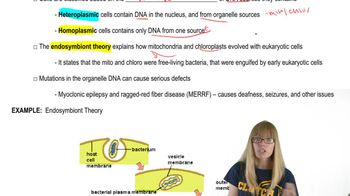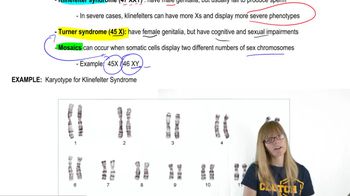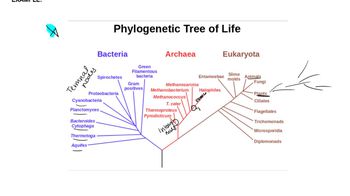Table of contents
- 1. Introduction to Genetics51m
- 2. Mendel's Laws of Inheritance3h 37m
- 3. Extensions to Mendelian Inheritance2h 41m
- 4. Genetic Mapping and Linkage2h 28m
- 5. Genetics of Bacteria and Viruses1h 21m
- 6. Chromosomal Variation1h 48m
- 7. DNA and Chromosome Structure56m
- 8. DNA Replication1h 10m
- 9. Mitosis and Meiosis1h 34m
- 10. Transcription1h 0m
- 11. Translation58m
- 12. Gene Regulation in Prokaryotes1h 19m
- 13. Gene Regulation in Eukaryotes44m
- 14. Genetic Control of Development44m
- 15. Genomes and Genomics1h 50m
- 16. Transposable Elements47m
- 17. Mutation, Repair, and Recombination1h 6m
- 18. Molecular Genetic Tools19m
- 19. Cancer Genetics29m
- 20. Quantitative Genetics1h 26m
- 21. Population Genetics50m
- 22. Evolutionary Genetics29m
22. Evolutionary Genetics
Phylogenetic Trees
Problem 11
Textbook Question
Textbook QuestionIn Island Melanesia and Polynesia, most mtDNA haplotypes are of Asian ancestry, whereas Y chromosome haplotypes are predominantly New Guinean. Provide a hypothesis for this sex-biased distribution.
 Verified Solution
Verified SolutionThis video solution was recommended by our tutors as helpful for the problem above
Video duration:
3mPlay a video:
Was this helpful?
Key Concepts
Here are the essential concepts you must grasp in order to answer the question correctly.
Mitochondrial DNA (mtDNA)
Mitochondrial DNA is the genetic material found in mitochondria, inherited maternally. It is often used in studies of population genetics and ancestry because it can reveal maternal lineage and migration patterns. In the context of Island Melanesia and Polynesia, the predominance of Asian mtDNA haplotypes suggests significant maternal gene flow from Asia to these regions.
Recommended video:
Guided course

Organelle DNA Characteristics
Y Chromosome
The Y chromosome is one of the two sex chromosomes in humans, inherited paternally. It carries genes related to male sex determination and is passed from father to son. The presence of predominantly New Guinean Y chromosome haplotypes in Island Melanesia and Polynesia indicates a strong paternal lineage and suggests that male migration patterns differ from those of females in these regions.
Recommended video:
Guided course

Human Sex Chromosomes
Sex-biased Gene Flow
Sex-biased gene flow refers to the unequal contribution of males and females to the genetic makeup of a population. This phenomenon can occur due to cultural practices, migration patterns, or social structures that favor one sex over the other in terms of reproduction and movement. In this case, the hypothesis for the observed distribution of mtDNA and Y chromosome haplotypes may involve differing migration behaviors or reproductive strategies between males and females in these island populations.
Recommended video:
Guided course

Sex-Linked Genes

 8:16m
8:16mWatch next
Master Phylogenetic Trees with a bite sized video explanation from Kylia Goodner
Start learningRelated Videos
Related Practice


